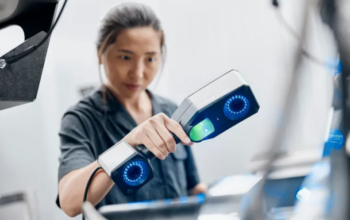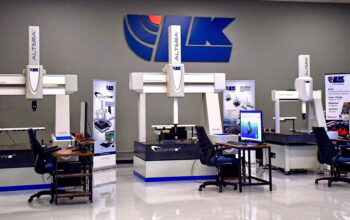Dr. Oakley, Yukon Vet is the remarkable story of a veterinarian in the remote, rugged expanses of northwest Canada and Alaska. One aspect of her story is how she takes advantage of familiar technology to open new worlds and new possibilities — using television (“seeing at a distance”) and microscopy (“viewing what is small”) to their full potential.
Through her TV series, in its tenth season on Nat Geo Wild, she lets viewers see and experience the daily life of an all-species veterinary practice in the faraway Yukon.
And now, with a new premium-quality portable microscope, she performs a wide range of immediate diagnoses while out in the field and uses a display to engage and educate animal owners, students, and her television audience by letting them see and experience details not visible to the naked eye.

From mice to moose
“I treat all creatures wild and wooly, everything from mice to moose and bears, along with farm animals and pet dogs, cats and hedgehogs,” Dr. Michelle Oakley explains. “I started my training as a zoo vet and as a wildlife vet for Yukon Fish and Wildlife, and then developed a mixed mobile clinical practice, that added another layer of difficulty. Here in the Great White North, it’s the mobile part that is especially challenging.”
Originally from Indiana, she earned an undergraduate degree in zoology at the University of Michigan. While studying there, she traveled to the Yukon to serve as a field assistant on an arctic ground squirrel ecology study and met her future husband, Shane Oakley, a local wildland firefighter. She earned her doctorate in veterinary medicine from the Atlantic Veterinary College at the University of Prince Edward Island.
Based in the village of Haines Junction, population 800, Dr. Oakley covers thousands of square miles of Canadian and Alaska desolate wilderness, with the assistance of her teenage daughters who are her vet techs. The weather is often extremely harsh, the transportation options are very limited, and WiFi and cell service are rarely available.

Self-sufficient, all-purpose generalist
Although veterinary medicine is becoming increasingly specialized, Dr. Oakley usually needs to function as an extreme example of a self-sufficient, all-purpose generalist. “I see a lot of dogs, for example with various lumps and masses, and I would love to be able to send samples to an oncologist, but that would usually take a week or more.”
When she is out in the field, she is at each location for only a day or two and needs to perform diagnosis and treatment within that limited window of time, serving as both the pathologist and the surgeon. “I need a timely diagnosis so that I can treat the animal without delay. We rarely have the ability to come back for a later appointment”

High performance microscope
Dr. Oakley had discovered an outreach program that ZEISS launched during the COVID-19 pandemic to place top-of-the-line microscopes and cameras into schools across the U.S. She decided to reach out to the company “I used ZEISS binoculars and camera lenses, and I understood the impact a high quality, portable microscope could have on my practice,” she said. “And the ability to display images on an iPad would make a real difference in the educational work I do with students and interns.”
Joseph Huff, Head of Marketing, North America, ZEISS Research Microscopy Solutions, acknowledges “while the outreach program usually goes to schools we recognized that, although Dr. Oakley is not a classroom teacher, she has an enormous educational impact, engaging students directly in the Yukon and inspiring her TV viewers across the world.
The grant included a ZEISS Primo Star high performance upright light microscope and a ZEISS Axiocam capable of displaying images wirelessly on handheld devices. The Primo Star is designed to provide high quality images for health care microscopy applications in environmental conditions including classroom and laboratory settings as well as field work.
Transforming her practice
Even when Dr. Oakley is in her Haines Junction clinic or in her satellite clinic 600 miles away at the Alaska Wildlife Conservation Center, the availability of a high-performance microscope has been critically important to her practice. The sharp images that the microscope and camera produce enable her to take better advantages of telemedicine with specialists.
She is also better able to accurately and quickly perform a broad range of techniques: urinalysis, parasitology, microbiology and cytology on her own, avoiding the delays and risks of transporting samples. Urine samples, and fresh hair plucks and skin scrapings don’t always travel well to an outside laboratory.
The real transformative impact of the microscope has been in the field where portability and battery power are essential. Dr. Oakley will take her team by boat along the coast to a half dozen remote villages, sometimes under harsh conditions, relying only on the human and equipment capabilities that they bring with them. The team does what they can, knowing that it will be a year or longer before they will be able to return.
A natural educator
Her microscope, like her television series, inspires and engages. “I have observed a noticeable difference in compliance when I am able to show and explain details to pet owners and farmers,” she explains. “They can see and understand better, rather than just listening to my explanation. A picture of a mange mite on my ZEISS microscope is worth more than a thousand words!”
“More dramatic is the impact on students. Up here in the Yukon, young people do not have museums and IMAX theaters. The microscope with the handheld display opens whole new worlds to them, sparking interest in science and their natural surroundings. They become intellectually engaged and excited by the opportunity to actually participate in my work with animals. I am happy to be able to pass on this wonderful gift to them.”








